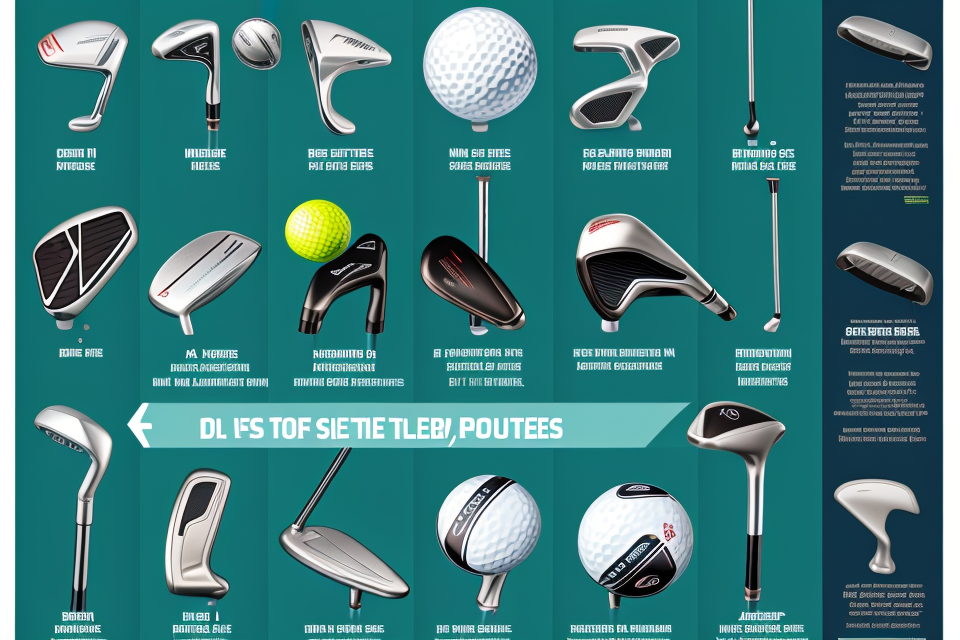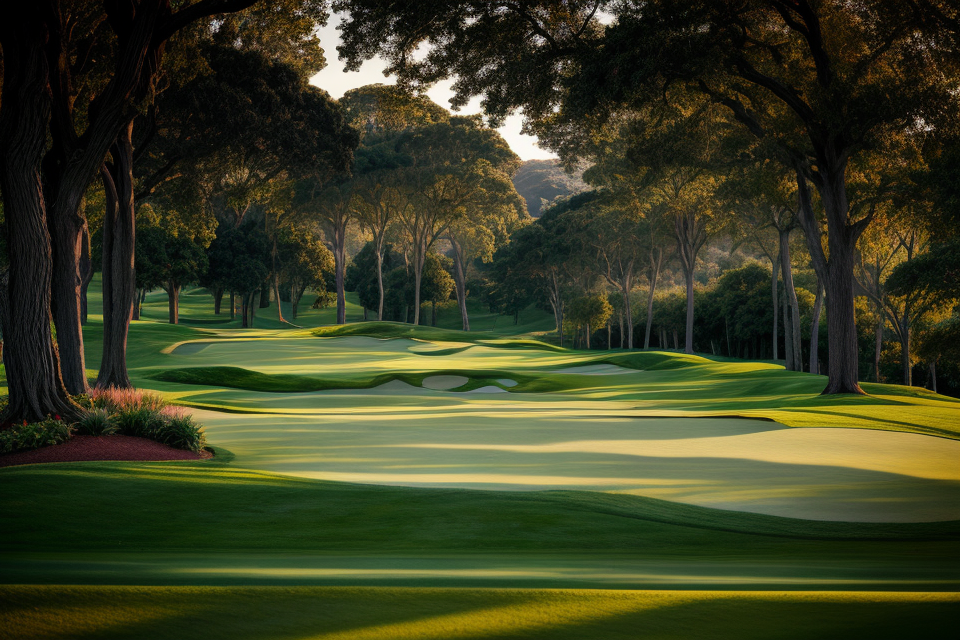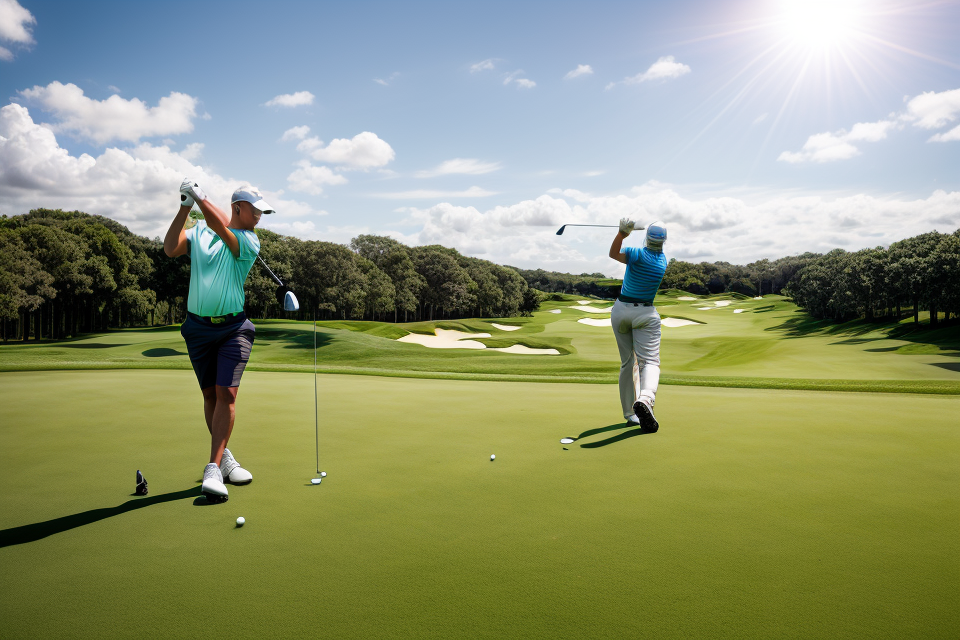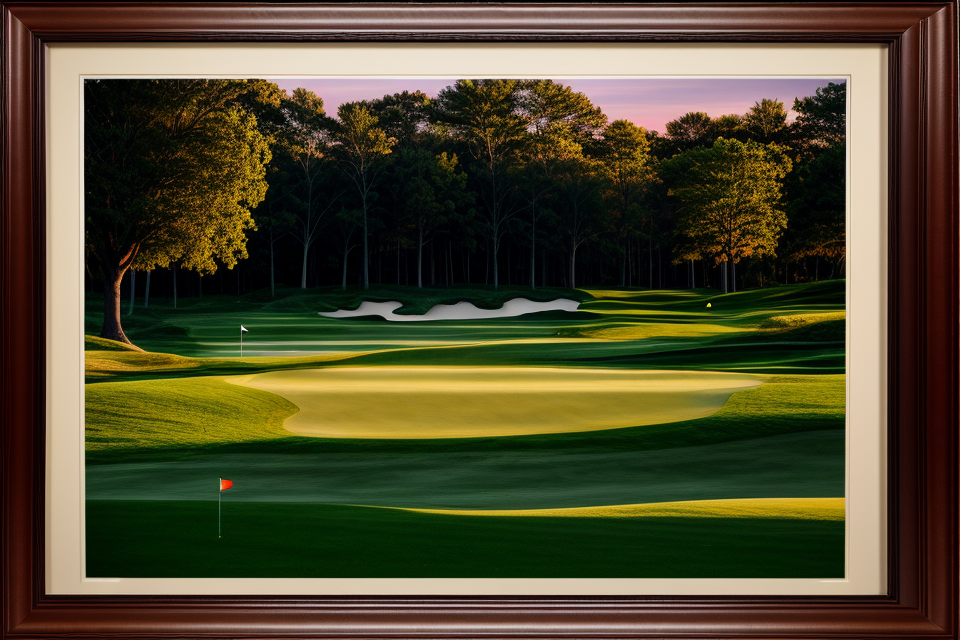
Golf is a game that requires precision and skill, and one of the most important tools for achieving success on the course is the golf club. But with so many different types of clubs available, it can be overwhelming to know which one to use in different situations. In this comprehensive guide, we will explore the different golf clubs and what they mean, helping you to understand the nuances of each club and how to choose the right one for your game. From drivers to putters, we will cover it all, giving you the knowledge you need to take your golf game to the next level. So, whether you’re a seasoned pro or a beginner just starting out, read on to discover the exciting world of golf clubs.
Understanding Golf Clubs
Golf Club Anatomy
The anatomy of a golf club is a crucial aspect to understand when it comes to comparing different clubs. It consists of three main parts: the shaft, the grip, and the head.
- The Shaft
The shaft is the long, slender part of the golf club that connects the head to the grip. It is typically made of graphite or steel and is responsible for transmitting the power generated by the golfer’s swing to the ball. Different shaft materials and flexes can affect the club’s overall performance, such as distance, accuracy, and feel. - The Grip
The grip is the area where the golfer holds the club. It is usually covered with a material like rubber or cord to improve the grip and prevent slippage during the swing. Grip size and texture can also vary between clubs and be customized to the golfer’s preference. - The Head
The head is the part of the club that strikes the ball. It is typically made of metal or a metal alloy and contains the club’s face, which is responsible for imparting the spin and speed to the ball. The head also includes the club’s loft, which determines the ball’s trajectory and how much it will rise in the air. The shape, size, and design of the head can greatly affect the club’s performance, such as its forgiveness, accuracy, and distance.
Types of Golf Clubs
When it comes to golf clubs, there are four main types that every golfer should be familiar with: woods, irons, hybrids, and putters. Each type of golf club serves a specific purpose and is designed to help golfers hit the ball a certain distance and with a specific trajectory.
Woods
Woods are the longest and most lofted clubs in a golfer’s bag, making them ideal for hitting long shots off the tee or for reaching the green in two. They are typically used on par 4 and par 5 holes, as well as on shorter par 3 holes where a long shot is required.
There are two main types of woods: the driver and the fairway wood. The driver is the lowest lofted wood and is used to hit the longest shots, while the fairway wood has a higher loft and is used for shots that need to travel a shorter distance, such as on par 4 and par 5 holes.
Irons
Irons are the most commonly used clubs in a golfer’s bag and are used for a variety of shots, including approach shots, pitches, and chips. They are designed to deliver the ball a shorter distance with a lower trajectory, making them ideal for accurate shots that need to stop quickly on the green.
Irons come in a set of clubs, ranging from the 1-iron to the 9-iron, with each club having a different loft and distance range. The higher the number, the higher the loft and the shorter the distance the ball will travel.
Hybrids
Hybrids are a combination of woods and irons and are designed to replace the lower numbered irons in a golfer’s bag. They are similar to woods in that they have a lower loft and are designed to hit the ball a longer distance, but they are also similar to irons in that they have a more controlled trajectory and are ideal for accurate shots.
Hybrids are typically used on par 4 and par 5 holes, as well as on shorter par 3 holes where a longer shot is required. They are also used as an alternative to long irons, such as the 2-iron and 3-iron, which can be difficult to control.
Putters
Putters are the shortest and lowest lofted clubs in a golfer’s bag and are used for hitting the ball onto the green and sinking putts. They have a flat face and a straight shaft, making them ideal for precise shots that need to travel a short distance.
Putters come in a variety of styles, including the traditional blade putter, the mallet putter, and the belly putter. Each style has its own unique features and benefits, and golfers often choose a putter based on their personal preference and putting style.
Comparing Golf Clubs
Factors to Consider
When comparing golf clubs, several factors must be considered to determine which club is best suited for your game. Here are some of the most important factors to consider:
Distance
One of the most critical factors to consider when comparing golf clubs is distance. The distance a golf club can hit a ball is determined by its loft angle, which is the angle between the clubface and the ground when the club is in a normal address position. Higher loft angles result in shorter distances, while lower loft angles result in longer distances. For example, a driver with a loft angle of 8.5 degrees will typically travel farther than a 3-wood with a loft angle of 15 degrees.
Accuracy
Another important factor to consider when comparing golf clubs is accuracy. The accuracy of a golf club is determined by its forgiveness, which refers to how well the club performs when struck off-center. A more forgiving club will perform better than a less forgiving club when the ball is struck off-center. In general, clubs with a higher loft angle and a larger clubhead are more forgiving than clubs with a lower loft angle and a smaller clubhead.
Forgiveness
Forgiveness is an essential factor to consider when comparing golf clubs, especially for high handicap golfers. Golfers with a higher handicap tend to hit the ball off-center more frequently, so it’s crucial to choose a club that is more forgiving. Clubs with a higher loft angle and a larger clubhead are typically more forgiving, but it’s essential to choose a club that suits your swing type and skill level.
Launch Angle
The launch angle of a golf club is the angle at which the ball is launched into the air. A higher launch angle results in a higher ball flight, while a lower launch angle results in a lower ball flight. Some golfers prefer a higher launch angle for more distance, while others prefer a lower launch angle for more control. When comparing golf clubs, it’s essential to consider the launch angle of each club to determine which one is best suited for your game.
Spin Rate
The spin rate of a golf club is the amount of backspin generated by the clubhead when it strikes the ball. A higher spin rate results in more backspin, which can help the ball stop faster on the green. However, a higher spin rate can also result in a lower ball flight and less distance. When comparing golf clubs, it’s essential to consider the spin rate of each club to determine which one is best suited for your game.
Comparison Chart
- Woods
- Driver
- Lowest lofted wood
- Longest drive distance
- Used for tee shots and long fairway shots
- Fairway Woods
- Higher loft than driver
- Used for long fairway shots and for reaching par 5s in two
- Hybrid
- Replacement for long irons
- Higher launch angle
- Used for longer shots and for replacing 3-4 iron
- Driver
- Irons
- 3-9 Irons
- Used for mid-range shots and approach shots
- Pitching and Gap Wedges
- Higher loft than irons
- Used for short approach shots and for reaching par 5s in two
- Sand Wedge
- Highest loft of all irons
- Used for bunker shots and for long approach shots
- 3-9 Irons
- Hybrids
- Replacement for Long Irons
- Higher Launch Angle
- Lower loft than irons
- Used for shorter approach shots and for reaching par 5s in two
- Putters
- Blade Putters
- Slightly curved blade shape
- Slightly more sensitive to stroke and requires more skill
- Mallet Putters
- Larger sweet spot
- More forgiving
- Putter Length and Weight
- Proper length and weight for individual player
- Influences the player’s stroke and accuracy.
- Blade Putters
Choosing the Right Golf Clubs
When choosing the right golf clubs, there are several factors to consider. These factors will help you determine the best golf clubs for your skill level, swing type, physical characteristics, and budget. Here are some of the most important factors to consider:
- Skill Level: Your skill level is one of the most important factors to consider when choosing golf clubs. Beginner golfers typically require more forgiving clubs that are easier to hit, while advanced golfers can opt for clubs that offer more control and precision.
- Swing Type: Your swing type is another important factor to consider. If you have a fast swing speed, you may benefit from using a driver with a lower loft angle to maximize distance. If you have a slower swing speed, you may benefit from using a driver with a higher loft angle to improve accuracy.
- Physical Characteristics: Your physical characteristics can also play a role in choosing the right golf clubs. For example, if you have a slower swing speed, you may benefit from using a heavier clubhead to generate more power. If you have a longer armspan, you may benefit from using a longer shaft to improve control.
- Budget: Finally, your budget is an important factor to consider when choosing golf clubs. Golf clubs can range in price from a few hundred dollars to several thousand dollars, so it’s important to set a budget and choose clubs that fit within your budget. However, it’s important to remember that while cheap golf clubs may be more affordable, they may not offer the same performance as higher-end clubs.
Golf Club Fitting
When it comes to choosing the right golf clubs, one of the most important factors to consider is golf club fitting. Golf club fitting refers to the process of selecting the right golf clubs that are tailored to your individual needs and preferences. This can help improve your swing, increase distance, and enhance accuracy. In this section, we will discuss the different types of golf club fitting.
Professional Fitting
Professional fitting is the most comprehensive and personalized way to get the right golf clubs. It involves working with a professional club fitter who will assess your swing, physical characteristics, and playing style to recommend the best golf clubs for you. This process typically includes a full swing analysis, clubhead speed measurement, launch angle measurement, and a fitting session with a variety of clubs. The fitter will make adjustments to the clubs, such as changing the shaft, grip, or loft, to ensure that they fit your swing and game.
Professional fitting is the best option for golfers who want the most precise and customized fit. It can be time-consuming and expensive, but it is worth the investment for serious golfers who want to improve their game.
Clubmaker Fitting
Clubmaker fitting is a more affordable alternative to professional fitting. It involves working with a clubmaker who has experience in designing and building custom golf clubs. The clubmaker will assess your swing, physical characteristics, and playing style to recommend the best golf clubs for you. The clubmaker will then build the clubs to your specifications, using high-quality components, such as shafts, grips, and heads.
Clubmaker fitting is a good option for golfers who want a more personalized fit than what is available off the shelf, but do not want to pay for the full range of services offered by a professional fitter. It is also a good option for golfers who are interested in customizing their clubs further than what is possible with off-the-shelf clubs.
DIY Fitting
DIY fitting involves measuring your physical characteristics, such as your height, weight, and arm length, and using this information to select the right golf clubs. You can use online resources, such as club fitting tools, to help you choose the right clubs based on your measurements and playing style. You can also seek advice from friends, family, or golf professionals to help you make the right choices.
DIY fitting is the most affordable and convenient option for golfers who do not have access to a professional fitter or clubmaker. However, it is important to note that DIY fitting may not be as precise as professional or clubmaker fitting, and may require more trial and error to find the right clubs for your game.
Golf Club Brands
Major Golf Club Manufacturers
Major golf club manufacturers are companies that have been in the industry for many years and have established a reputation for producing high-quality golf clubs. Some of the most well-known major golf club manufacturers include:
- TaylorMade: Known for their innovative designs and technologies, TaylorMade golf clubs are popular among both professional and amateur golfers. Their clubs are known for their distance, accuracy, and feel.
- Callaway: Callaway golf clubs are known for their forgiveness and easy-to-hit characteristics. They offer a wide range of clubs for players of all skill levels, from beginners to professionals.
- Titleist: Titleist is a brand that is known for its premium quality and attention to detail. Their clubs are designed to provide maximum performance and control for golfers of all abilities.
- Ping: Ping is a brand that is known for its precision-engineered clubs. Their clubs are designed to provide maximum accuracy and distance, with a focus on feel and control.
Up-and-Coming Golf Club Manufacturers
In addition to the major golf club manufacturers, there are also a number of up-and-coming brands that are gaining popularity among golfers. Some of these brands include:
- Cobra: Cobra is a brand that is known for its innovative designs and technologies. Their clubs are designed to provide maximum distance and accuracy, with a focus on forgiveness and easy-to-hit characteristics.
- Mizuno: Mizuno is a brand that is known for its premium quality and attention to detail. Their clubs are designed to provide maximum performance and control for golfers of all abilities.
- Wilson: Wilson is a brand that is known for its affordability and versatility. Their clubs are designed to provide maximum value for golfers of all skill levels, from beginners to professionals.
Golf Club Customization
In addition to choosing from a variety of major and up-and-coming golf club manufacturers, many golfers also choose to customize their clubs to fit their individual needs and preferences. This can include adjusting the loft and lie of the clubs, changing the shaft materials and flexes, and adding grips or other accessories. Customizing your golf clubs can help you to optimize your performance on the course and improve your overall game.
FAQs
1. What are the different types of golf clubs?
There are several types of golf clubs, including woods, irons, hybrids, and putters. Woods are typically used for long-distance shots and have a larger head and less loft than irons. Irons are used for medium-distance shots and have a smaller head and more loft than woods. Hybrids are a combination of woods and irons and are designed to be easier to hit than traditional long irons. Putters are used for short-distance shots on the green and have a flat or slightly upturned face.
2. What is the difference between a driver and a fairway wood?
A driver is a type of wood that is typically used for long-distance shots from the tee box. It has a large head and a low loft, which allows the ball to travel a long distance with a high trajectory. A fairway wood is also a type of wood, but it is typically used for medium-distance shots from the fairway. It has a smaller head and a higher loft than a driver, which allows for more control over the shot.
3. What is the difference between a hybrid and a long iron?
A hybrid is a type of club that is designed to be easier to hit than traditional long irons. It has a larger head and a lower loft than a long iron, which makes it easier to hit the ball a long distance with a high trajectory. A long iron, on the other hand, is a type of iron that is typically used for long-distance shots, but it has a smaller head and a higher loft than a hybrid, which makes it more difficult to hit the ball a long distance.
4. What is the difference between a putter and a wedge?
A putter is a type of club that is used for short-distance shots on the green. It has a flat or slightly upturned face and is designed to roll the ball smoothly towards the hole. A wedge, on the other hand, is a type of iron that is typically used for medium-distance shots around the green. It has a high loft and is designed to lift the ball into the air and stop it quickly on the green.
5. What is the difference between a sand wedge and a lob wedge?
A sand wedge is a type of wedge that is designed to help players get out of bunkers. It has a high loft and a sharp edge on the face, which allows the ball to be lifted out of the sand and stop quickly on the green. A lob wedge, on the other hand, is a type of wedge that is typically used for high-lofted shots around the green. It has a lower loft than a sand wedge and is designed to lift the ball into the air and stop it quickly on the green.


